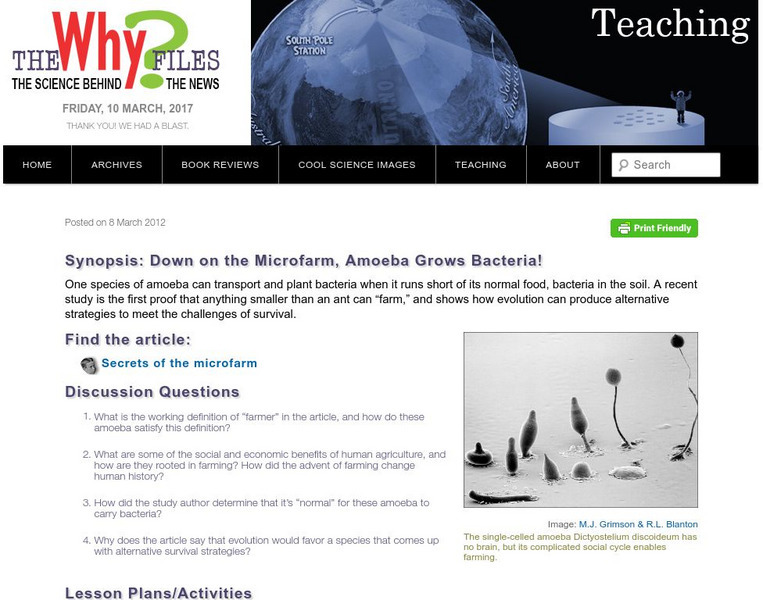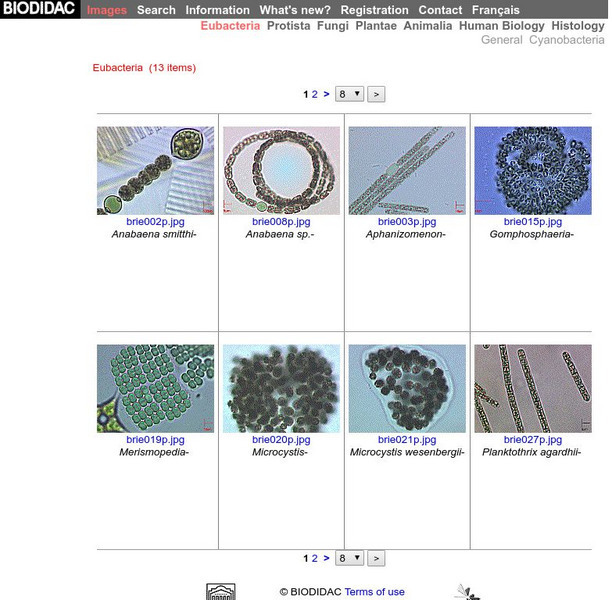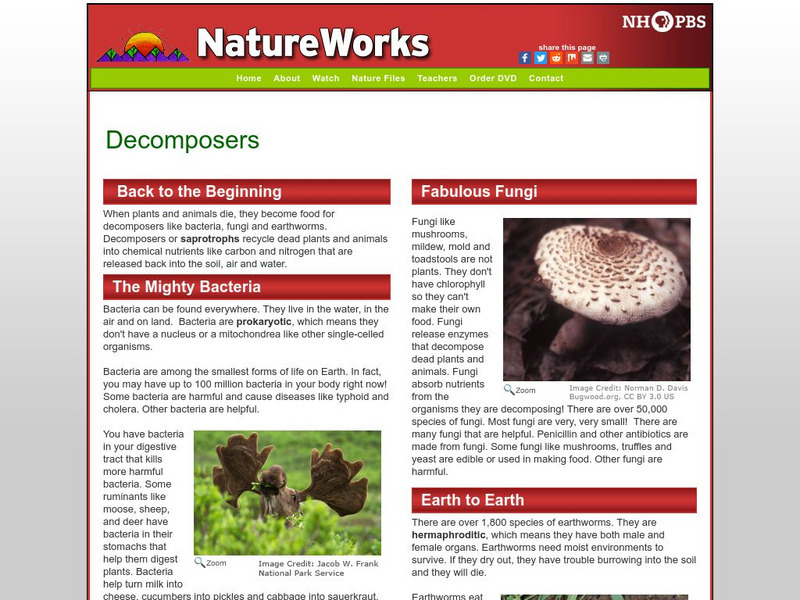Hi, what do you want to do?
BiologyWise
Biology Wise: Classification of Bacteria
Explains how bacteria are classified by gram staining for medical purposes, and how they are classified by scientists based on Bergy's Manual of Systematic Classification. Also presents a list of hundreds of bacteria organized into their...
BiologyWise
Biology Wise: Different Types of Bacteria
Discusses the different criteria used to classify bacteria and the groups of bacteria within each category. Groups are organized by characteristics such as morphology, shape, cell wall structure, and presence of flagella.
BiologyWise
Biology Wise: List of Bacteria
Describes the structure of bacteria, where bacteria can be found, and how they are classified using gram staining. Includes lists of bacteria organized by gram staining response and whether they have a capsule shape. Also includes a list...
BiologyWise
Biology Wise: Helpful and Harmful Types of Bacteria
Some types of both beneficial and harmful bacteria are identified and described. States characteristics, where each is found, and their benefits or the diseases that they cause.
BiologyWise
Biology Wise: Facts About Cocci
Describes the characteristics of cocci bacteria, their shape, how they arrange themselves in pairs and groups, common forms of cocci, their method of reproduction, and types of cocci that cause diseases in humans. Includes examples of...
University of Wisconsin
The Why Files: Down on the Microfarm
Explanation of how an amoeba can farm to make its own food when necessary.
TED Talks
Ted: Ted Ed: How the Food You Eat Affects Your Gut
The bacteria in our guts can break down food the body can't digest, produce important nutrients, regulate the immune system, and protect against harmful germs. Shilpa Ravella shares the best foods for a healthy gut.
Illustrative Mathematics
Illustrative Mathematics: F le.a & N Rn Extending the Definitions of Exponents 2
A biology student is studying bacterial growth. She was surprised to find that the population of the bacteria doubled every hour. Aligns with the F-LE.A and N-RN.A.1 standards.
Success Link
Success Link: Microorganisms
Lesson plans to examine bactieria and how they grow. The main lesson page indicates that there are seven training labs, but there are only two operating links. Those two are worth exploring.
Other
Biology Guide: Pathogens and Disease
Students learn about pathogens and disease. Some topics explored in the tutorial are bacteria, parasites, gene technology, and non-communicable diseases.
University of Missouri
Microbes in Action: Classroom Activities: Simple Staining of Microbes [Pdf]
With this simple stain, students can observe the shape of yeast and bacteria under the microscope. Lesson plan gives a lab procedure, teacher instructions, points for discussion, and additional activities. Lab does require the purchase...
University of Ottawa (Canada)
Biodidac: Images: Eubacteria
An image collection of specimens from the Kingdom Eubacteria. Includes some photographs as well as diagrams of various species of bacteria.
BiologyWise
Biology Wise: Information About Nitrifying and Denitrifying Bacteria
Learn about the important role that nitrifying and denitrifying bacteria play in the nitrogen cycle.
The Association of the British Pharmaceutical Industry
Abpi: Infectious Diseases
A self-paced lesson on infectious diseases including bacterial, fungal, viral, and parasitic infections. Each disease featured discusses symptoms and treatment.
PBS
Nh Pbs: Nature Works: Decomposers
This site gives a detailed overview of "decomposers": bacteria, fungi, and earthworms. Content includes a look at how decomposers contribute to a symbiotic relationship.
Centers for Disease Control and Prevention
Centers for Disease Control: Bam! Body and Mind: Lurking in the Locker Room
Explore a boys' or a girls' locker room to see where bacteria and fungi are commonly found, and learn how to protect oneself.
Discovery Education
Discovery Education: Curriculum Center: Science
The Discovery Channel provides numerous topics that are the most popular science topics taught in upper elementary and middle school. Content is organized by topics (Bacteria, Oceans, Solar System, etc.); all topics include quick facts,...
TED Talks
Ted: Ted Ed: How Pandemics Spread
A discussion about the globalization of disease, and the implications of a pandemic. Mark Honigsbaum describes the history of pandemics and how scientists can help prevent future outbreaks. [8:00]
Alabama Learning Exchange
Alex: Invasion of the Body Snatchers
In this WebQuest, sudents will be working in cooperative learning groups to research bacteria, viruses, and the immune system via the Internet. Young scholars will be taking notes and answering questions to show the teacher for approval....
Woods Hole Oceanographic Institution
Woods Hole Oceanography Institute: Bacteria at Hydrothermal Vents
Discover more about the thermophiles (bacteria) that live in hydrothermal vents ranging from the ocean floor to Yellowstone hotsprings.
Khan Academy
Khan Academy: Prokaryotes Questions
This is a ten-question quiz pertaining to Prokaryotes.
Khan Academy
Khan Academy: Prokaryote Classification and Diversity
Different groups of prokaryotes. Evolutionary relationships of bacteria and archaea. Extremophiles.
Khan Academy
Khan Academy: What Is Antibiotic Resistance?
Antibiotic resistance describes a bacteria's ability to survive while being exposed to antibiotics. Topics explored are the following: How does antibiotic resistance develop exactly?; How do we measure antibiotic resistance?; How...
Khan Academy
Khan Academy: Virulence Factors of Listeria Monocytogenes
This quiz provides questions related to the growth and genetics of bacteria. This study resource from Khan Academy provides practice questions for the MCAT.






















